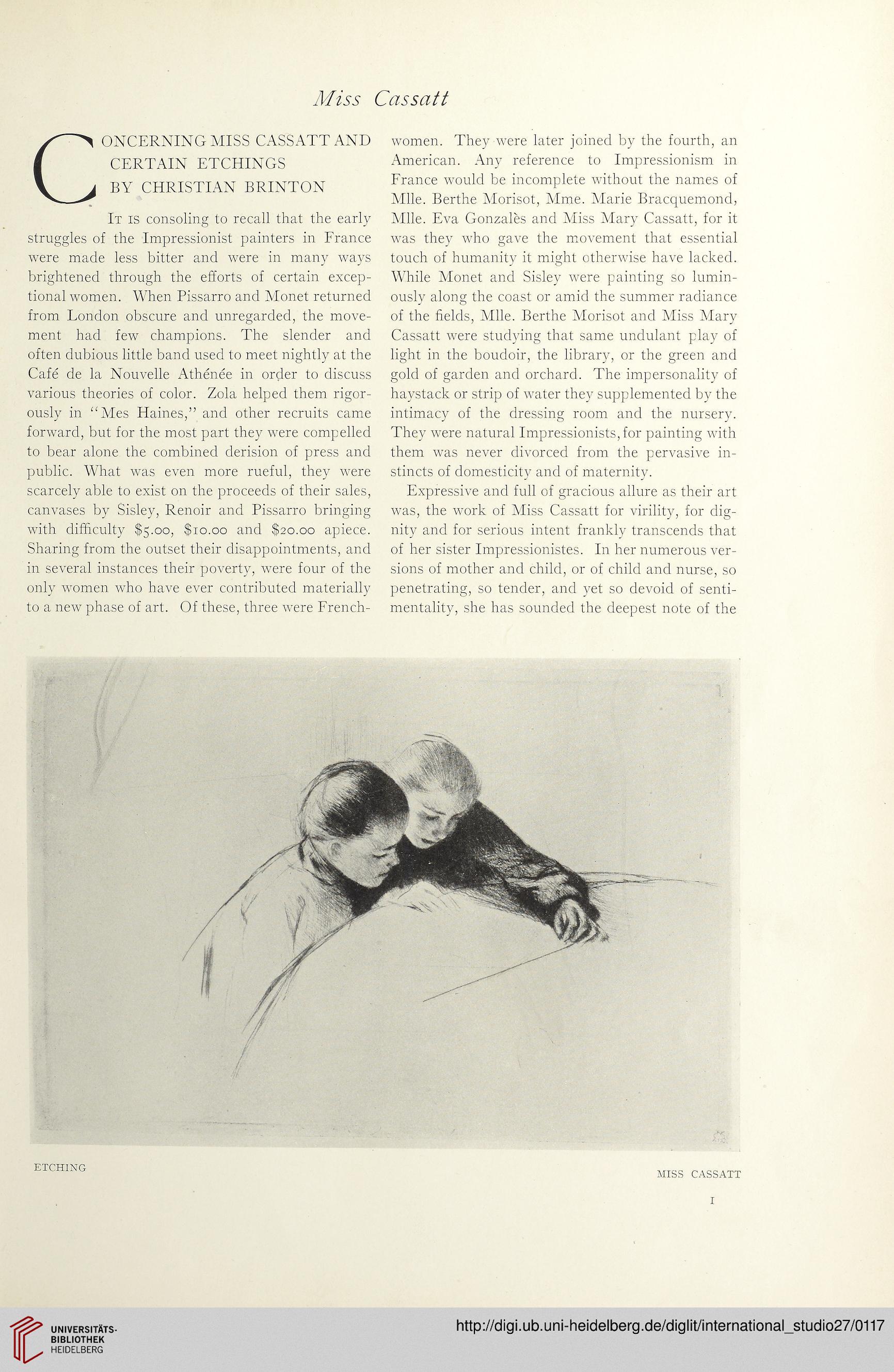Miss Cassatt
CONCERNING MISS CASSATT AND
CERTAIN ETCHINGS
BY CHRISTIAN BRINTON
It is consoling to recall that the early
struggles of the Impressionist painters in France
were made less bitter and were in many ways
brightened through the efforts of certain excep-
tional women. When Pissarro and Monet returned
from London obscure and unregarded, the move-
ment had few Champions. The slender and
often dubious little band usecl to meet nightly at the
Cafe de la Nouvelle Athenee in order to discuss
various theories of color. Zola helped them rigor-
ously in “Mes Haines,” and other recruits came
forward, but for the most part they were compelled
to bear alone the combined derision of press and
public. What was even more rueful, they were
scarcely able to exist on the proceeds of their sales,
canvases by Sisley, Renoir and Pissarro bringing
with difhculty $5.00, $10.00 and $20.00 apiece.
Sharing from the outset their clisappointments, and
in several instances their poverty, were four of the
only women who have ever contributed materially
to a new phase of art. Of these, three were French-
women. They were later joined by the fourth, an
American. Any reference to Impressionism in
France would be incomplete without the names of
Mlle. Berthe Morisot, Mme. Marie Bracquemond,
Mlle. Eva Gonzales and Miss Mary Cassatt, for it
was they who gave the movement that essential
touch of humanity it rnight otherwise have lackecl.
While Monet and Sisley ivere painting so lumin-
ously along the coast or amid the summer radiance
of the fields, Mlle. Berthe Morisot and Miss Mary
Cassatt were studying that same undulant play of
light in the boudoir, the library, or the green and
golcl of garden and orchard. The impersonality of
haystack or strip of water they supplemented by the
intimacy of the dressing room and the nursery.
They were natural Impressionists, for painting with
them was never divorced from the pervasive in-
stincts of domesticity and of maternity.
Expressive and full of gracious allure as their art
was, the work of Miss Cassatt for virility, for dig-
nity and for serious intent frankly transcends that
of her sister Impressionistes. In her numerous ver-
sions of mother and child, or of child and nurse, so
penetrating, so tender, and yet so clevoid of senti-
mentality, she has sounded the deepest note of the
1
CONCERNING MISS CASSATT AND
CERTAIN ETCHINGS
BY CHRISTIAN BRINTON
It is consoling to recall that the early
struggles of the Impressionist painters in France
were made less bitter and were in many ways
brightened through the efforts of certain excep-
tional women. When Pissarro and Monet returned
from London obscure and unregarded, the move-
ment had few Champions. The slender and
often dubious little band usecl to meet nightly at the
Cafe de la Nouvelle Athenee in order to discuss
various theories of color. Zola helped them rigor-
ously in “Mes Haines,” and other recruits came
forward, but for the most part they were compelled
to bear alone the combined derision of press and
public. What was even more rueful, they were
scarcely able to exist on the proceeds of their sales,
canvases by Sisley, Renoir and Pissarro bringing
with difhculty $5.00, $10.00 and $20.00 apiece.
Sharing from the outset their clisappointments, and
in several instances their poverty, were four of the
only women who have ever contributed materially
to a new phase of art. Of these, three were French-
women. They were later joined by the fourth, an
American. Any reference to Impressionism in
France would be incomplete without the names of
Mlle. Berthe Morisot, Mme. Marie Bracquemond,
Mlle. Eva Gonzales and Miss Mary Cassatt, for it
was they who gave the movement that essential
touch of humanity it rnight otherwise have lackecl.
While Monet and Sisley ivere painting so lumin-
ously along the coast or amid the summer radiance
of the fields, Mlle. Berthe Morisot and Miss Mary
Cassatt were studying that same undulant play of
light in the boudoir, the library, or the green and
golcl of garden and orchard. The impersonality of
haystack or strip of water they supplemented by the
intimacy of the dressing room and the nursery.
They were natural Impressionists, for painting with
them was never divorced from the pervasive in-
stincts of domesticity and of maternity.
Expressive and full of gracious allure as their art
was, the work of Miss Cassatt for virility, for dig-
nity and for serious intent frankly transcends that
of her sister Impressionistes. In her numerous ver-
sions of mother and child, or of child and nurse, so
penetrating, so tender, and yet so clevoid of senti-
mentality, she has sounded the deepest note of the
1





